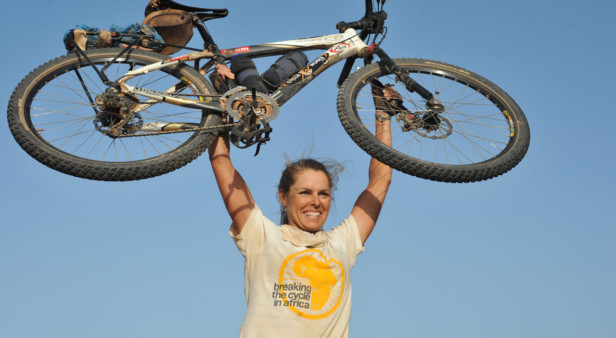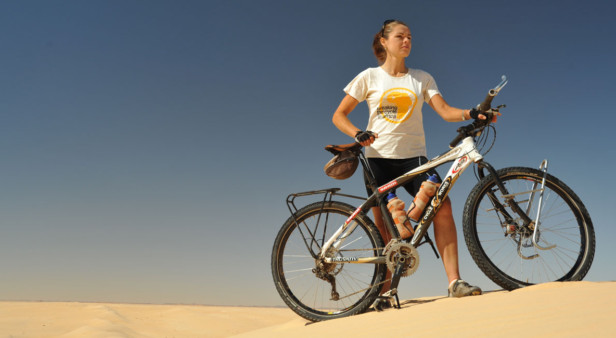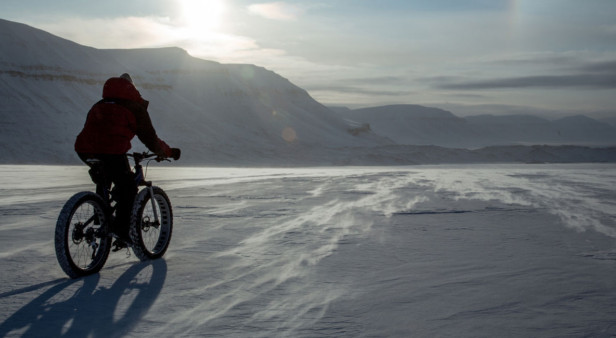What can you tell us about your new expedition?
It’s called Breaking The Cycle South Pole and the idea is it will be the first bicycle crossing of the Antarctic continent via the South Pole. I’ve always been intrigued by Antarctica and it’s been an impossible dream in the past to take a bike down there, but now with technology as it is and with my vast experience from all of the other expeditions that I’ve done, I feel like it’s almost a duty to use those skills and try to extend myself a little more.
And you’ll be raising funds to fight AIDS in Africa?
Yes, this time I’m raising funds and awareness for AIDS in Africa, as a response to my last expedition through the continent. It was one of the issues I learnt a lot about on my ride across Africa and I felt when I finished that expedition that I had this great education program and people learnt from it, but I wanted to do a little more. So now we have a great way of raising funds and awareness for that.
What can you tell us about the special bike you’ll be using on the ice?
It’s a ‘fat bike’, which is often used in extreme snow conditions in North America and Europe, and also in the sand in Australia. It’s got 12-cm-wide tyres – and obviously the more flotation, the better. But the thing that makes my bike a little more special is it’s a two-wheel-drive, or an all-wheel drive, bicycle. It doesn’t make me go faster, but I spend a little less energy trying to stay upright – and it takes quite a bit of energy to stay upright in those conditions!
It’s a distance of 1850 km with temperatures ranging between -10 and -40°C, what kind of training will you need to do?
Well I did a test run with the support team up in Spitsbergen in the Norwegian islands, which are level with the top of Greenland. I’d never been in extreme-cold conditions before so we just had to see if I was in the right ballpark. We got down to about -30°C conditions at one time, so it was a very good test of how I coped with the conditions, how the bike coped and what kind of improvements we needed in terms of clothing and bike design. That was in 2013, when I first started putting this project together. The rest of the time has really been about finding the funds, pulling all of the outreach programs together, I also have to work and I’ve just published a book, so I don’t have time to do longer rides all the time. I work hard in the gym and keep my fitness at a level where I can push from, so that when I get the funds I need and have a schedule leading up to the journey, it will ensure that I’m ready. That schedule will include training in the sand in Australia, altitude training in Ladakh in the Indian Himalayas and also in Greenland because it’s very similar to Antarctica, which is the highest, driest, windiest continent on earth. So once I get through all of those tests, then I’ll definitely be ready!
And members of the public will be able to follow your progress via an app?
Yes, people will be able to follow the journey in real time and I’ll send little bits of information back every day, so you can check where I am and see the map. One of the ways I plan to raise funds to fight AIDS in Africa is through an app called Charity Miles, where you can be part of my team and select whether you’re going to walk, run or bike – if you walk or run, 25 cents a mile goes into the fund and if you cycle, 10 cents a mile goes in – but you don’t personally put the money in, Charity Miles has other sponsors. It’s a different model but if we can get large numbers of people taking part in this, then we could raise quite a lot of money and at the same time people will become motivated and engaged in the expedition, and it will encourage health and fitness, so it’s a win-win for everybody.
Which adventure has been your personal favourite so far?
It’s a bit hard to choose, they’re all special for different reasons. Firstly, I cycled through Europe as a way of seeing Europe and that’s where I got my passion from and I just loved that way of travelling. And then the next journey was across Russia and that was very special because it was when it was changing to its own country before our eyes, after seven years of communism. And then with Australia, I wanted to see how my own country matched up to other parts of the world and it was about education in sustainable development. I started in Canberra and by the time I got to my home farm in Western Australia, it was around 17,000 km so I cycled in the back gate just to see how it was all connected – and then back to Canberra again! Africa was another level up again; it was 22,000 km from the westerly tip to the most easterly tip, through 20 different countries. So logistically it was more difficult and because we were filming it we used a support vehicle, which added to the security issues, whereas bikes tend to be able to slip under the net. Though it might not seem so, it’s probably a bit safer without a vehicle in some situations. But I had a great network of connections before I left and help in places where I needed it. You wouldn’t even be able to cross the border into Somalia without the right connections, so it was an amazing journey on one of the most culturally diverse continents on earth.
It sounds like all of your expeditions have aimed to engage and educate followers.
Yeah, so with Australia, I wrote a book called Out There And Back and then with Africa there was a book and a feature documentary and we’re cutting a TV series. Now this time with Antarctica, I’ve got a really amazing team with me to make sure we can do everything in terms of engaging people during the journey and a film afterwards, which will have very high quality footage and content. As with my previous projects I will be making an educational contribution, this time working with Cool Australia, Museum Victoria and Intuitive Media Australia.
When times are tough on the journey and you think you can’t continue, what motivates or inspires you to keep going?
I think one of the key things is I always spend a lot of time thinking about the key mission: what is it that I want to do, what am I passionate about, what difference can I make? I have to 100 percent believe in it so that when it’s a difficult time – especially with all the supporters and school kids following and all the effort that’s gone into it – if I really believe in the mission, I’m not going to stop. You’ve got to be able to see the big picture. It’s an absolute privilege to be able to do these things, even if it’s very hard to set them up, and that’s not lost on me … I’d never take anything for granted.
Image 3 via Phil Coates.


